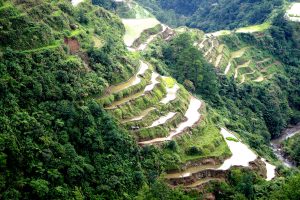
The Banaue Rice Terraces are a National Cultural Treasure of the Philippines and are considered to be the 8th Natural Wonder of the World by many Filipinos. The view is spectacular, majestic and inspiring. The Banaue Rice Terraces are located on the mountains of Ifugao and were carved there about 2,000 years ago by the ancestors of the present day Philippines. It is said that they were built by hand and were used to plant rice.
Here are some interesting facts about the Banaue Rice Terraces:
1. They are located about 1500 meters (5,000 Ft.) above the sea level on a 10,360 square kilometers (about 6000 square miles) mountainside.
2. The terraces are irrigated by water from catchment areas in the rainforests above it.
3. Today, although a few Ifugaos still plant vegetables on the terraces, most prefer concentrating on the tourist dollars brought by those who want to see the historic terraces.
4. It is said that the terraces is one of the most spectacular engineering feats to have been accomplished in the ancient world.
5. In 1995, the UNESCO declared it a world heritage center. 6. The Banaue Rice Terraces look like a giant’s step stretching skywards. Some of the terraces are as high as 4,000 meters above the sea level. 
6. Ifugao is the name of the province as well as the people who dwell there.
7. Since many young Ifugaos are not interested in farming, the soil on the terraces has started eroding and some of the terraces had to be redone.
8. The people of the province love having fun during the festival of tunggul. During the festival, they drink bayah or rice beer, eat rice cakes, and chew betel nut.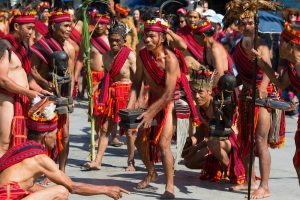
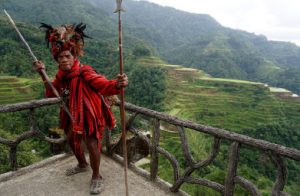
If you are lucky, you will be greeted by an Ifugao warrior who may scare you with his weapons, appearance, and demeanor but he is part of the spectacle that makes the Banaue Terrace amazing and worth seeing.
I fear no challenges in my life from trekking the Sagada cave, hiking the Alps in Switzerland, zip lining in Costa Rica, river rafting in the cold waters of the West Virginia mountains, to showing my bravery to fight an Ifugao tribesman. This is the adventure of traveling. Nothing ventured – nothing earned.
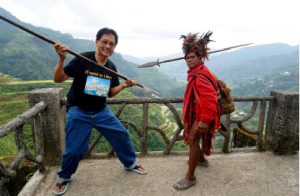
While I was up in the mountains, I was very lucky to have met an Ifugao tribesman who showed me how to handle a spear which his weapon to hunt or defend himself.
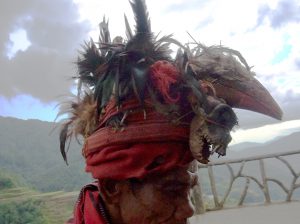
The Ifugao man wears a headress made of monkey head and the “hom” bird from the mountains of Banaue. He uses this headless to attract tourists and to protect him from evil and danger.
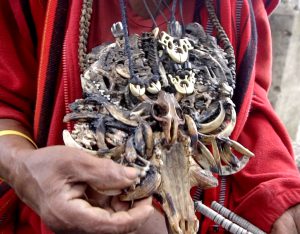
He also wears a neck ornament given to him by his grandfather. The ornament is mad of different kinds of animal skulls and animal bone parts. It is quite unusual and unique for any tourists who sees him.
